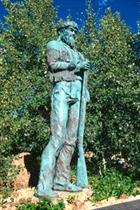|
The Arizona Rocks communities of Flagstaff, Page and Williams in northern Arizona are surrounded by one of the highest concentrations of National Parks, Monuments and National Forests in the entire United States.
The community of Williams has the registered name “Gateway to the Grand Canyon.” The Canyon is just up state Highway 64 or you can hop on the daily train departures aboard the Grand Canyon Railway. Hiking, air tours, river rafting, horseback riding, Ranger interpretive programs, guided tours or just sitting on the rim enjoying the majesty of the grandest canyon of them all.
Just down the road to the south and east of the Grand Canyon is the historic mountain town of Flagstaff situated in the world's largest ponderosa pine forest at the base of the 12,633-feet-high Humphreys Peak (the highest point in Arizona).
 To the east of town just off state Highway 89 Wupatki National Monument and Sunset Crater Volcano --National Monument are located nearly side-by-side. First occupied in 1100 A.D., Wupatki National Monument was once home to the farmers and traders of the Anasazi and Sinagua people. The Monument has a visitors center with interpretive programs and self-guided walks take you through ancient dwellings including several pueblo-style structures and a large open-air amphitheater. Nearby is Sunset Crater Volcano National Monument. It last erupted in 1180 A.D., leaving behind incredible lava flows and a beautiful crater that can be seen for miles. To the east of town just off state Highway 89 Wupatki National Monument and Sunset Crater Volcano --National Monument are located nearly side-by-side. First occupied in 1100 A.D., Wupatki National Monument was once home to the farmers and traders of the Anasazi and Sinagua people. The Monument has a visitors center with interpretive programs and self-guided walks take you through ancient dwellings including several pueblo-style structures and a large open-air amphitheater. Nearby is Sunset Crater Volcano National Monument. It last erupted in 1180 A.D., leaving behind incredible lava flows and a beautiful crater that can be seen for miles.
Walnut Canyon National Monument is just east of Flagstaff off Interstate 40. Hike down into Walnut Canyon and you walk in the footsteps of the people that lived here over 900 years ago. The historic single story structures and cliff dwellings were occupied from about 1100 to 1250. And it is a sacred place. The people that lived here moved on to become the modern pueblo people of today.
Follow Highway 89 north on your way to Page, Arizona through the vast open lands of the Navajo Nation and join the course of the Colorado River and you will come to Lee’s Ferry, named for and settled by Mormon John D. Lee who established the first Colorado River crossing at this site. A stone fort, built in 1874 as a result of unrest between area Navajo and settlers and a trading post constructed around 1913 still stand. Lees Ferry is the location that half-day-rafting tour lands after their journey through the majestic Marble Canyon stretch of the Colorado River. Those smooth water trips begin on the outskirts of Page at the base of the Glen Canyon Dam, March through October.
The community of Page, Arizona is perched on a mesa overlooking Lake Powell and the Glen Canyon National Recreation Area. Its 1,960 miles of shoreline are equivalent to the entire Western coast of the continental United States. Rainbow Bridge is the world's largest natural bridge. This natural stone arch is accessible by tour boat and is a spectacular photo opportunity.
Monument Valley to the east of Page is a Navajo Tribal Park. The scenery is simply spellbinding with free-standing monuments rising to heights of 400 to 1000 feet. The landscape overwhelms. It is everything you see: the monuments, the mesas and buttes, the shrubs, the magnificent colors of the valley…and it is everything you feel: the atmosphere of an ancient people and its culture, the smell of the air, the listening of sounds.
For more information visit www.ArizonaRocks.com or call: 1.800.842.7293 for Flagstaff information; 1.800.863.0546 for the Williams Grand Canyon Chamber of Commerce; and 1.888.261.PAGE for the Page Lake Powell Tourism office.


|